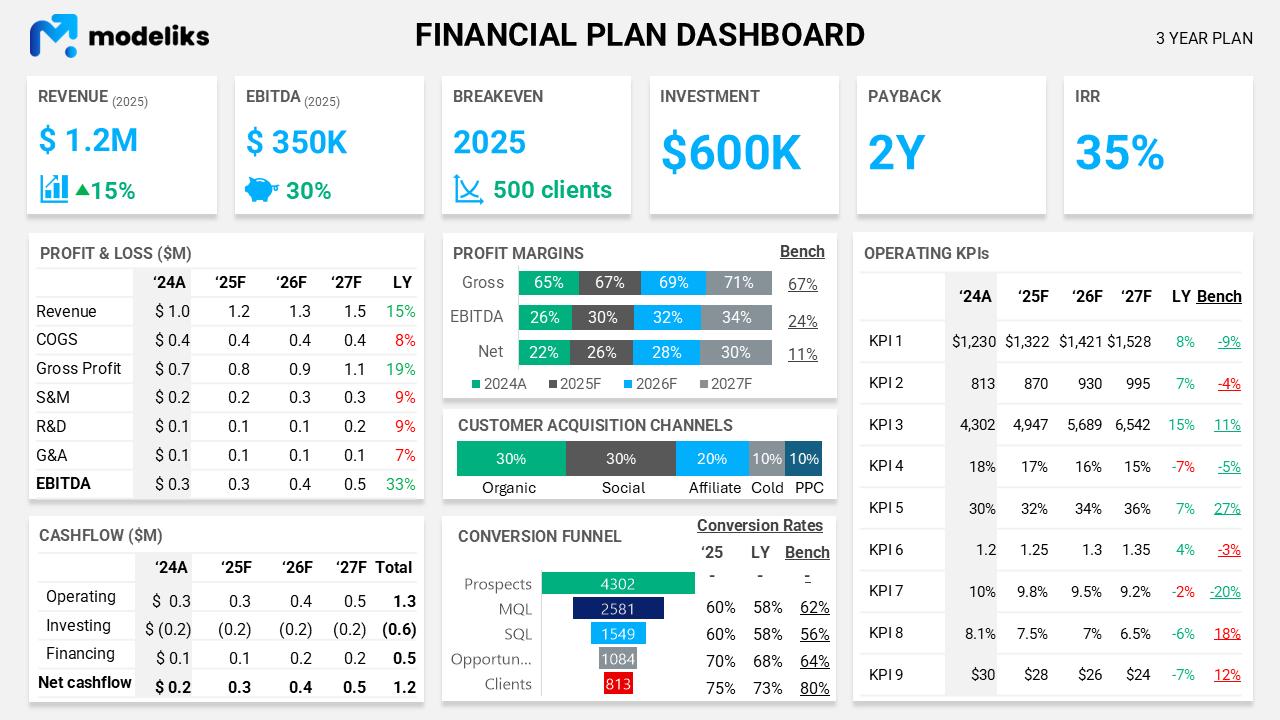Our Transportation Financial Model Structure covers all the essential aspects you need to consider when starting or scaling a Transportation business. By following this structure, you can better understand your revenue streams, costs, and assets, helping you optimize profitability and strategically plan for growth.
Financial planning is a cornerstone for the sustainability and growth of any transportation business; it provides a detailed framework to manage revenues, costs, and resources efficiently. Whether starting anew or scaling up, a sound financial model helps in making informed decisions—identifying lucrative revenue streams and optimizing operational efficacy. The following guide outlines the key elements you need to consider when developing a financial plan for a transportation business (however, this requires diligence). Although challenges may arise, embracing strategy is essential. Because of this, understanding the nuances of finance is crucial.
The Transportation financial model structure
This transportation financial model outlines typical revenues, direct costs, employees, expenses, and assets you must consider when starting or growing your transportation business. It might provide you with ideas for new and profitable revenue streams; however, be aware that challenges can arise. Although the framework is comprehensive, it is essential to adapt it to specific needs because each business is unique. This model serves as a foundation, but success ultimately depends on implementation.
Revenues
- Freight Charges: Revenue generated from the transportation of goods; this is calculated by multiplying the number of shipments by the charge per shipment.
- Passenger Services: Income from transporting passengers, determined by the number of passenger tickets sold and the price per ticket.
- Leasing Services: Earnings from leasing out vehicles, computed by multiplying the number of vehicles leased by the lease rate.
- Advertising Revenue: Income from advertisements placed on transport vehicles, estimated by the number of ads placed and the rate per ad.
- Logistics and Supply Chain Services: Revenue from offering logistics solutions, calculated by the number of contracts and the average contract size.
- Storage Services: Income from providing storage facilities, assessed by the volume of storage used and storage rates.
Cost of goods sold
- Fuel Costs: Direct expenses related to vehicles.
- Driver Wages: Salary expenditures for drivers engaged on transport routes.
- Vehicle Maintenance: Regular upkeep and repair costs for the transportation fleet; this is crucial for operational efficiency.
- Insurances: Costs tied to insuring both vehicles and goods, although the significance of these expenses is often underestimated.
Employees
- Drivers: Responsible for transporting goods and passengers safely.
- Logistics Managers: Oversee logistics operations to ensure efficient routing.
- Customer Service Representatives: Handle inquiries and manage bookings and complaints.
- Maintenance Technicians: Perform regular maintenance and repair works on vehicles.
- Administrative Staff: Manage paperwork, billing, and various office management tasks.
Operating expenses
- Rent: Cost associated with renting office and warehouse space.
- Utilities: Expenses for electricity, water, and other utilities.
- Communications: Phone, internet, and courier costs.
- Licensing and Permits: Governmental fees required for operating a business.
- Marketing and Advertising: Costs associated with promoting the business.
- Office Supplies: Everyday supplies needed for operating the office.
- Fuel Surcharge: Pass-through costs added to customer prices due to fluctuating fuel prices.
- Software and Technology: Expenses for software subscriptions and technology solutions used in operations.
- Professional Fees: Legal, accounting, and consulting fees.
- Vehicle Leasing/Depreciation: Costs related to leasing vehicles or their depreciation value.
Assets
- Fleet of Vehicles: Cars, trucks, or buses used for transportation activities.
- Warehousing Facilities: Buildings used for the storage of goods.
- IT Infrastructure: Hardware and software crucial for operational and logistical management.
- Office Equipment: Desks, computers, and communication devices.
Funding Options
- Bank Loans: Traditional loans sourced from financial institutions.
- Venture Capital: Equity investment from VC firms in exchange for ownership stakes.
- Government Grants: Non-repayable funds supporting transportation businesses through various programs.
- Leasing: Agreements to use vehicles without the necessity of purchasing them outright.
Driver-based financial model for Transportation
A truly professional financial model for a transportation business is grounded in the operating KPIs (often dubbed “drivers”) specific to this sector. Vehicle utilization rate measures how efficiently the fleet is utilized; on-time delivery rate indicates the percentage of deliveries completed punctually. Cost per mile reflects the average expense incurred for every mile traversed by the vehicles. Furthermore, the load factor serves as the ratio of actual cargo carried against the total capacity of the vehicle. Average revenue per truck illustrates the income generated by each truck operating within the fleet. Fuel efficiency is expressed in miles per gallon earned by fleet vehicles, while maintenance costs per vehicle denote the average expenses associated with upkeep. Lastly, the turnover rate of drivers highlights the frequency with which drivers leave and are replaced in the business.
Driver-based financial planning is a method for identifying crucial activities, referred to as ‘drivers,’ and represents a strategic approach that significantly influences business outcomes. It enables the creation of financial plans predicated on these pivotal activities. By establishing connections between financial results and requisite resources—such as personnel, marketing budgets, equipment, etc.—organizations can optimize their strategies. If you desire further insights into driver-based financial planning and its efficacy, consider watching the founder of Modeliks elucidate this concept in the accompanying video.
Need a business plan?
Create one with Modeliks AI in the next hour!
AI powered business planning for Startups and SMEs.
The financial plan output
The aim of financial forecast outputs is to enable you, your management team, board members, or investors to quickly grasp how your Transportation business will fare in the future. It provides comfort because the plan is well thought out, realistic, and feasible. Additionally, it allows for an understanding of what investments are necessary to implement this plan and what the anticipated returns on those investments will be. To reach these objectives, here’s a concise template on how to effectively showcase your financial plan.

Beyond this one-page summary of your plan, you will require the three projected financial statements: Profit and Loss , which assesses your business profitability over time; Balance Sheet , offering a snapshot of assets, liabilities, and equity at a specific moment; and Cash Flow Statement , which monitors cash inflows and outflows from operating, financing, and investing activities. However, it’s essential to remember that clarity and precision are paramount.
Transportation financial model summary
A professional transportation financial model will help you think through your business; it can identify resources you need to achieve your targets and set goals. Measure performance, raise funding, and make confident decisions to manage and grow your business—however, a well-structured financial model acts as a guiding beacon for strategic planning. This is crucial because it ensures sustainability and profitability in the dynamic market scenario, although many overlook its importance.
If you need help with your financial plan, try Modeliks , a financial planning solution for SMEs and startups or contact us at contact@modeliks.com and we can help.
Author:
Blagoja Hamamdjiev
, Founder and CEO of
Modeliks
, Entrepreneur, and business planning expert.
In the last 20 years, he helped everything from startups to multi-billion-dollar conglomerates plan, manage, fundraise, and grow.

TAKE MODELIKS FOR A SPIN
Not sure which plan?
Start with a 15 days free trial.
You will have access to the full functionality of Modeliks. The only restriction in the free trial is that you cannot download or share your business plan outside Modeliks. Credit card is not required to subscribe for the free trial.






